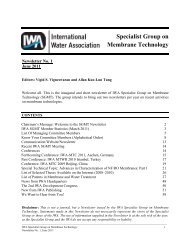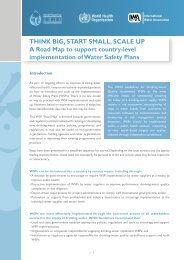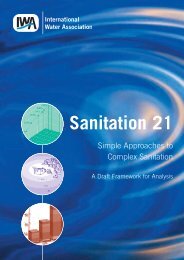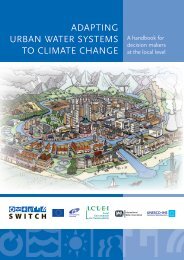Specialist Group on ANAEROBIC DIGESTION Newsletter - IWA
Specialist Group on ANAEROBIC DIGESTION Newsletter - IWA
Specialist Group on ANAEROBIC DIGESTION Newsletter - IWA
You also want an ePaper? Increase the reach of your titles
YUMPU automatically turns print PDFs into web optimized ePapers that Google loves.
Operati<strong>on</strong> and modeling of anaerobic sequencing batch reactors (ASBR) in the<br />
treatment of complex effluents<br />
by Andrés D<strong>on</strong>oso-Bravo<br />
Instituti<strong>on</strong>:<br />
School of Biochemical Engineering, P<strong>on</strong>tificia Universidad Católica de Valparaíso<br />
New PhD C<strong>on</strong>tact:<br />
Postdoctoral Researcher<br />
Department of Chemical Engineering and Envir<strong>on</strong>mental Technology<br />
University of Valladolid. Spain<br />
Supervisor:<br />
Dr. Rolando Chamy<br />
Abstract:<br />
Anaerobic digesti<strong>on</strong> has become a c<strong>on</strong>solidated and sustainable technology due to its<br />
ec<strong>on</strong>omical and envir<strong>on</strong>mental benefits. Nowadays, anaerobic digesti<strong>on</strong> is applied in a<br />
wide variety of organic waste and wastewater and presents comparable advantages over c<strong>on</strong>venti<strong>on</strong>al aerobic<br />
processes. Several anaerobic reactors have been developed, mainly UASB, EGSB and CSTR reactors, however,<br />
new c<strong>on</strong>figurati<strong>on</strong>s are being developed and studied to increase the amount of waste treated by anaerobic<br />
digesti<strong>on</strong>. One of the most important features of the Anaerobic Sequencing Batch Reactors (ASBR) is its<br />
operati<strong>on</strong>al flexibility as a result of its operati<strong>on</strong>al variables that may be manipulated such as the reacti<strong>on</strong> time,<br />
the feeding time or the type of feeding.<br />
In this work, an Anaerobic Sequencing Batch Reactor (ASBR) has been operated for 8 m<strong>on</strong>ths to treat low<br />
strength sewage with high suspended organic matter c<strong>on</strong>tent simulating domestic wastewater. Three phases of<br />
operati<strong>on</strong> with increasing Organic Loading Rates (OLR) have been carried out: 0.4 (phase I), 0.8 (phase II) and<br />
1.2 kg COD/m 3·d (phase III). During the whole experimental period, adequate values of the stability parameters<br />
(pH, total alkalinity) were obtained. During phases I and II, the removal efficiencies of organic matter<br />
(expressed as total COD) and total suspended solids ranged between 50 and 60%. However, these values<br />
decreased to 15-25% in phase III, due to the less HRT the methanogenic biomass was washed out of the reactor<br />
Afterward, a two-phase anaerobic system using Anaerobic Sequencing Batch Reactors (ASBR) treating the<br />
same simulated wastewater, to optimize the activity of both populati<strong>on</strong>s was implemented. Two reactors in<br />
series were set, the first <strong>on</strong>e was hydrolytic/acidogenic, while the sec<strong>on</strong>d <strong>on</strong>e was a methanogenic. Instantaneous<br />
feeding was used in both reactors. This c<strong>on</strong>figurati<strong>on</strong> will promote solid removal reaching higher efficiencies.<br />
During the experiment, a 69% and 50% of removal efficiencies of total cod removal were obtained for a OLR of<br />
0.63 and 1.22 kgCOD/m 3·d, respectively. The Solubilized Organic Fracti<strong>on</strong> (SOF) was within a range of 0.3 -<br />
0.6 gCOD solubilized /gpCOD removed and an average <strong>on</strong> the Acidified Organic Fracti<strong>on</strong> (AOF) of 0.6 gCOD vfaproduced/gsCOD<br />
fed , produced in the hydrolytic-acidogenic reactor. These are good results c<strong>on</strong>sidering the low<br />
COD influent and the high fracti<strong>on</strong> level of solids c<strong>on</strong>tent. The methanogenic reactor presented VFA removal<br />
fracti<strong>on</strong> (VFARF) value between 0.4 – 0.6 gCOD vfa-removed /gCOD vfa-fed for the OLR of 0.63 and 1.22. An overall<br />
good behaviour of the system was achieved during the whole experimentati<strong>on</strong>, showing that the two-phase<br />
system was stable, robust and effective for simulated domestic wastewater by anaerobic digesti<strong>on</strong>.<br />
Then 2 anaerobic sequencing reactors were implemented assessing two operati<strong>on</strong> modalities batch and fedbatch,<br />
in the phenolic wastewater treatment using an unacclimated biomass was evaluated. It is important to note<br />
that many industries do not have a c<strong>on</strong>tinuous discharge of phenol in their effluents, though phenol may be<br />
released occasi<strong>on</strong>ally because of a seas<strong>on</strong>al change or abnormality in the upstream process. In these cases, it is<br />
necessary to acquire acclimated biomass or to utilize rapid biomass adaptati<strong>on</strong> in order to treat the effluent. The<br />
batch reactor showed a poor performance at 5 g/l of cod with a 10, 25 and 40% of the phenol cod, despite a<br />
readily co-substrate was used in the treatment. A fast adaptati<strong>on</strong> of the biomass was performed in the fed-batch<br />
reactor using phenol as the <strong>on</strong>ly carb<strong>on</strong> source, reaching a 100% of phenol removal in 10 days. The best results<br />
were obtained with a 400 mg/l (160 mg/l·d) after 40 days of operati<strong>on</strong> reaching over 95% of phenol removal.<br />
The phenol c<strong>on</strong>centrati<strong>on</strong> impaired the biomass settleability in both reactors, causing an important washout of<br />
biomass. A fed-batch modalities can be an alternative for the anaerobic treatment of phenolic wastewater.<br />
Finally, a model with 3 reacti<strong>on</strong>s and 2 populati<strong>on</strong>s was developed, implemented and validated with the<br />
experimental data previously obtained. A good correlati<strong>on</strong> between the simulated variables and the experimental<br />
data was obtained; hence this model might represent a potential tool to c<strong>on</strong>trol and predicti<strong>on</strong> purposes.<br />
<strong>IWA</strong> <str<strong>on</strong>g>Specialist</str<strong>on</strong>g> <str<strong>on</strong>g>Group</str<strong>on</strong>g> <strong>on</strong> Anaerobic Digesti<strong>on</strong><br />
16 June 2009 <strong>Newsletter</strong>

















